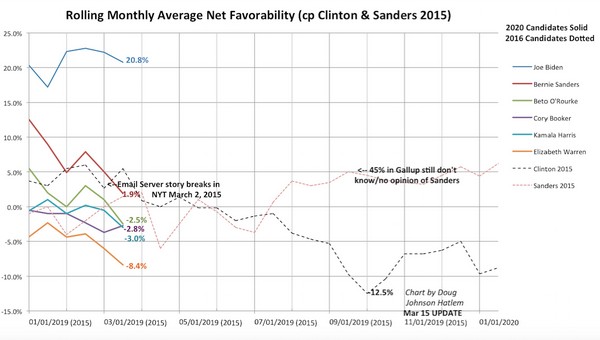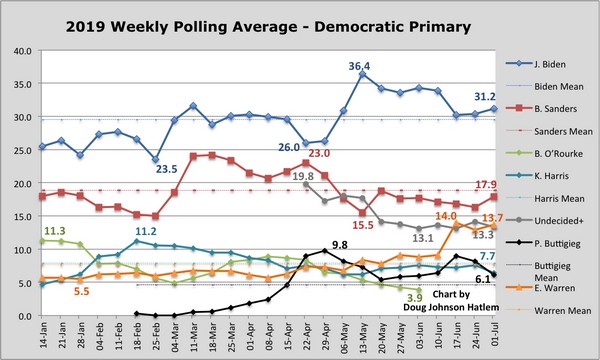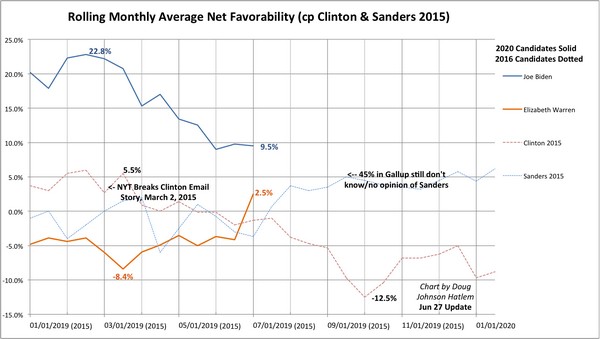Can Warren Beat Biden?
A Commentary By Doug Johnson Hatlem
On the first night of the Democratic debates, Massachusetts Senator Elizabeth Warren gave a master class in when to speak and when to keep one’s mouth shut. This is a lesson former Vice President Joe Biden could learn a lot from.
When Warren did speak, it was clear, passionate, on point and richly factual. On health care, she even surprised a bit by committing to eliminating private insurance where she has previously hedged her betting. The performance earned her a spot in the top three, a cut above the rest, with former Housing and Urban Development Secretary Julián Castro and New Jersey Senator Cory Booker.
On March 16, Warren was in the doldrums in terms of net favorability rating, according to my charting that tracks polling in the field in the previous month. Viewing her favorably or very favorably, on average, were 34.5% of respondents, while 42.9% viewed her unfavorably or very unfavorably for a net -8.4% average. Warren had just introduced her well-received plan to break-up big technology firms like Amazon, but she languished a whopping 28% behind Biden’s mid-March average of 20.8% net favorability. Booker, Kamala Harris and Beto O’Rourke hovered together between -2.5 and -3.0%. Bernie Sanders and Joe Biden were the only candidates in positive territory, but there was a massive difference between the two.
YouGov, when this update to the chart was released, had just introduced its weekly tracking of Democratic candidates’ favorability for the 2020 cycle, usually having all Democratic candidates somewhat lower than the national average. Biden was at +12% in YouGov’s March 10-12 ratings; Warren was at -10%.
Net favorability numbers are one of the better ways of forecasting the direction polling is heading, and two months later on May 20, Biden’s initial bounce after official entry in late April put him at 34.2% in my weekly tracking average for national Democratic primary polling, while Warren was at 7.8%. This put her right in line with her six-month average (7.7%) across all weeks for the first six months of polling in 2019. Warren’s net favorability was still stuck at -5.0%.
Right around this time in mid-May, however, Rasmussen Reports pegged Warren’s favorability at even (45 favorable, 45 unfavorable). At 46-44, she has been the only candidate besides Biden in Rasmussen polling during this six-month period to top President Trump in a hypothetical one-on-one matchup.
Warren entered the race early, on New Year’s Eve, and received a little bounce in media coverage and polling, but prior to Biden’s entry into the race, her weekly average was just 6.3%, usually putting her somewhere in the middle of the pack of second tier candidates (Harris, Booker, former Texas Congressman Beto O’Rourke, joined midway by South Bend, Indiana Mayor Pete Buttigieg) vying to rise above the Democratic primary’s 15% rule (more on that in a future piece) to join Sanders and Biden in serious competition. O’Rourke and Booker have now regularly faded below the 5% benchmark, while the highest any of these candidates managed on average prior to mid-June was O’Rourke with an 11.3% average as of January 14 and Harris at 11.2% on February 18.
Warren’s net favorability began to recover several weeks before her recent polling surge. Here is how things look if you hide all candidates except Biden and Warren in the most recent version of my Net Favourability Chart:
Biden has lost more than 10 net favorability points since mid-March, while Warren has gained a tick under a dozen.
While these numbers are bouncy, in no small part because of differences regarding which polling firms have been in the field recently, looking at the broad trend and at YouGov’s weekly tracking numbers specifically, gives a good indication of the remarkable distance that has closed between Warren and Biden’s net favorability over the last quarter. Where Biden was 22% better than Warren in YouGov’s March 10-12 polling, Warren passed Biden in the same favorability ratings late in May. In the most recent version (June 22-25 ), Biden is at +1% (47 favorable, 46 unfavorable) and Warren is at +5% (45, 40) numbers, a stunning net 26% reversal of fortunes for Warren versus Biden over mid-March.
Nevertheless, there are some troubles that remain for Warren. At +2.2%, she trails Biden (+9.3%) and Sanders (8.2%) in my most recent average of polling versus Trump for November 2020. While she has clearly made inroads with people of color since her worst times last fall after her DNA test, she is still regularly polling in the mid-to-high single digits with poll respondents who are Hispanic, African-American, Asian, Native American and people of color as a whole, even as her overall average has vaulted nearer the 15% mark.
As I noted early on in the cycle, drawing from and extending the work of others, polling in the first six months of the year prior to a Republican or Democratic primary is fairly, though not fully predictive, of likely outcomes. A candidate polling first, second or third during this period has won the nomination seven of the last 10 times the Democratic primary was competitive, nine of the last 10 times on the GOP side.
The fact that Warren has risen from the tangle of second tier candidates to polling in third position for eight straight weeks in my averaging is rather important.
Can Warren beat Biden? If her trend of seriously closing the favorability gap with Biden is any indication, if her broad but incomplete acceptability to the Clinton and the Sanders wings of the Democratic party is any indication, we would have to answer that question with a fairly emphatic, “yes, she can.”
Whether she will depends on a number of factors, some within, some beyond her control. In my view, the most critical tasks within her control are finding a way to a coherent foreign policy position and pivoting to an efficient answer on the DNA testing question that simultaneously educates regarding and firmly rejects blood quantum theories of race.
Doug Johnson Hatlem writes on polling, elections data, and politics. For questions, comments, or to inquire about syndicating this weekly column for the 2020 cycle in your outlet, he can be contacted on Twitter @djjohnso (DMs open) or at djjohnso@yahoo.com (subject line #10at10 Election Column).
See Other Political Commentaries.
Views expressed in this column are those of the author, not those of Rasmussen Reports. Comments about this content should be directed to the author or syndicate.
Rasmussen Reports is a media company specializing in the collection, publication and distribution of public opinion information.
We conduct public opinion polls on a variety of topics to inform our audience on events in the news and other topics of interest. To ensure editorial control and independence, we pay for the polls ourselves and generate revenue through the sale of subscriptions, sponsorships, and advertising. Nightly polling on politics, business and lifestyle topics provides the content to update the Rasmussen Reports web site many times each day. If it's in the news, it's in our polls. Additionally, the data drives a daily update newsletter and various media outlets across the country.
Some information, including the Rasmussen Reports daily Presidential Tracking Poll and commentaries are available for free to the general public. Subscriptions are available for $4.95 a month or 34.95 a year that provide subscribers with exclusive access to more than 20 stories per week on upcoming elections, consumer confidence, and issues that affect us all. For those who are really into the numbers, Platinum Members can review demographic crosstabs and a full history of our data.
To learn more about our methodology, click here.


